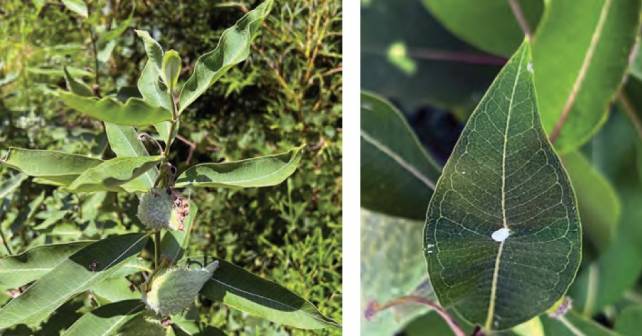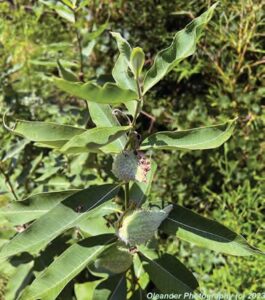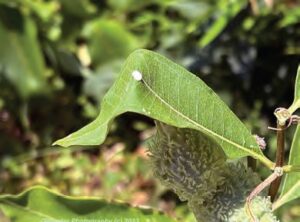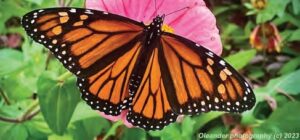
Milkweed, genus Asclepias, (named by Linnaeus as Asclepius (Ἀσκληπιός) in 1753) is a plant widely distributed across the United States containing about 140 species. The name pays homage to the Greek god Asclepius, the deity associated with medicine and symbolized by the wand of Asclepius. This plant has everything—ecological importance, toxic constituents, historical medical uses, human toxicity, and plays a role in the defense mechanisms of several insects, especially the Monarch butterfly.
The Plant
The milkweed is an upright, light green colored, large perennial, that can grow up to 6 feet tall (see image 1) Its large, oblong leaves and stems are covered in fine hairs which serve as a defense against insect predation (although more than 450 species of insects are known to dine on it). When the plant is cracked or lacerated it exudes an opaque, milky sap the plant is named for (see images 2,3). The plant’s flowers display in spherical clusters (umbels) near the top of the plant and are rosy to pink with strong sweet scent. The comma shaped green seed pods are about four inches long and covered in little finger-like projections (see image 4). They turn brown as they mature and split open revealing white fluffy fibers with seeds attached that distributes on the wind.
Toxins
Milkweed contains a group of cardioactive steroids, including calotropin and calactin, and voruscharin, highly potent cardenolides that are similar to steroidal cardenolides found in other toxic plants such as foxglove (Digitalis purpura), oleander (Nerium spp.), azalea and rhododendron (Rhododendron spp.) and Lily of the valley (Convallaria majalis). These cardenolide molecules are distributed throughout the plant, from the stems to the leaf tips. However, not all milkweed species have the same toxic cardenolide concentrations with some differing by orders of magnitude—from A. exaltata, A. tuberosa, A. purpurascens, and A. incarnata having virtually no detectable cardenolide levels in the leaves or latex, to A. curassavica A. linaria, and A. perennis with the highest levels of toxin.1–3
Medical Uses
Historically, various Asclepias species were used for a variety of medical purposes in the 1800s and early 1900s. These included expectorants, treatments for asthma, as an emetic, as a cathartic, as a diaphoretic for fever, and to ‘lower the actions of the heart.’ The sap was used as dressing for wounds and superficial ulcers to promote cicatrization (causing fibrous tissue at a wound site to reduce the size of a wound).4
Human Toxicity
Ingestion of plants containing cardioactive steroids have resulted in detectable digoxin concentrations, toxicity, and even death. Although cases of human milkweed exposure are rare, a 2013 case reported a 42-year-old man experiencing cardiac symptoms and nausea after consuming fried milkweed pods from a recipe he found online. In the ED, he was found to have a heart rate in the 40s, and a digoxin level of 1.0 ng/mL (cross reactivity of the assay) and a potassium of 4.2 mEq/L. He was observed for several hours and eventually discharged with minimal intervention.5 Symptoms of milkweed poisoning may include abdominal discomfort, nausea, vomiting, diarrhea, weakness, lethargy, and confusion, progressing to seizures, heart rhythm changes, and bradycardia.
Corneal injury and defects have been documented from direct contact of milkweed sap to the eye and any exposure should be immediately treated with copious water irrigation. Yang, in 2021, reported local milkweed toxicity resulting in a large corneal epithelial defect and diffuse stromal edema in a 13-year-old boy who presented to the emergency department after direct corneal exposure to milkweed latex. He was treated with antibiotic and steroid eye drops and had complete resolution in 18 days from injury.
Milkweed sap exposure to the skin can cause a significant contact dermatitis and poses a hazard for gardeners. Sap exposed areas should be cleaned soon after exposure with soap and copious water.
Antidote
There is no systemic antidote. It is unknown if digoxin specific antibody antidotal therapy would have any effect. Would likely recommend supportive care and cardiac observation for symptomatic patients.
Traditional Use
While common milkweed is well known to be toxic to humans, various Native American communities have consumed it for centuries (including the Tsalagi, Anishinaabe, Haudenoshonee, Lakota, Menominee, and Myaamia people) when prepared in a specific way. These culinary practices are very specific and result in minimal to no toxic exposure—only young plants are harvested and they are repeatedly boiled with several changes of water ridding the desired plant material of the water-soluble toxins.6
Animal World
The results of the milkweed species containing toxic cardenolides has far reaching effects into animal world. Plant strategies for survival are often a key factor of plant-insect co-evolution by herbivorous insects evolving offensive strategies by making use of the plant defenses for their own benefit.
One classic example are Monarch butterflies (Danaus plexippus) (image 5). They have no natural defenses—no fangs, claws, armor, or electric zaps. They also do not construct toxins from material they ingest. However, they do have one trick not to get eaten. They drink the sap of the milkweed while in their caterpillar stage and concentrate the cardioactive toxins from the plant in their bodies. These accumulated toxins do not affect them, as they have developed through time substitutions within the alpha subunit of their Na+/K+ ATPase, rendering the pump insensitive to cardiac glycosides otherwise known as ‘target-site-insensitivity.’5 The concentrated toxins persist in their tissues through their metamorphosis into butterflies and cause predators, primarily blue jays, to vomit and avoid eating them in the future. This technique, of making themselves unpalatable and very easy to be seen with their bright aposematic coloring, figures prominently into several fascinating defense mechanisms for an otherwise defenseless animal—including conditioned food aversion (it made me ill, I won’t eat that again), observational learning (others of your species see what happened to you and avoid the source), social transmission of preference (I see what you eat and follow your lead), neophobia (fear of new things, as in, I’m not going to eat that new food source), innate avoidance of bitter tastes (many animals don’t eat things that are bitter!).7
Conclusion
Milkweed (Asclepias spp) are plants of multifaceted importance, contributing to the environment, medicine, culture, and the balanced relationship between predators and prey in the animal kingdom. It’s truly an extraordinary plant worthy of carrying the rod of Asclepius.
 Dr. Hack is chief of the division of medical toxicology and vice chair for research at East Carolina University in Greenville, North Carolina.
Dr. Hack is chief of the division of medical toxicology and vice chair for research at East Carolina University in Greenville, North Carolina.
References
- Züst T, Petschenka G, Hastings AP, et al. Toxicity of milkweed leaves and latex: chromatographic quantification versus biological activity of cardenolides in 16 Asclepias species. J Chem Ecol. 2019;45(1):50-60.
- Yang JF, Beal CJ. corneal toxicity secondary to latex from Asclepias curassavica in a pediatric patient. Cornea. 2021;40(12):1607-1609.
- Brower LP, Fink LS. A natural toxic defense system: cardenolides in butterflies versus birds. Ann NY Acad Sci. 1985;443:171-188.
- Gaertner EE. The history and use of milkweed (Asclepias syriaca L.). Econ Bot. 1979;33:119–123.
- Simpson NS, Cole JB, Ellsworth H. What toxicity may result from ingestion of the plant pictured below? Answer: cardioactive steroid toxicity from common milkweed. J Med Toxicol. 2013;9(3):287-8.
- Everest MA, Gonella MP, Bowler HG, et al. How toxic is milkweed when harvested and cooked according to Myaamia tradition? Ethnobiology Letters. 2019;10(1):50-56.
- Groen SC, Whiteman NK. Convergent evolution of cardiac-glycoside resistance in predators and parasites of milkweed herbivores. Curr Biol. 2021;31(22):R1465-R1466.
Pages: 1 2 3 | Multi-Page










No Responses to “Toxicology Answer: Milkweed (Asclepias)”